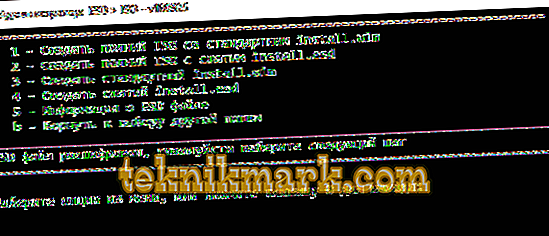As has been said many times, there are a huge number of different types of files of varying degrees of importance and attitude to the structure of the operating system and the computer as a whole. And quite often, users are faced with a situation where they have to deal with formats that are rarely seen in everyday life, and, therefore, the tool for working with it among the standard means of the operating system may simply not be. It is for leveling gaps and difficulties in such situations and there are articles like this. And within the framework of the above topic, we will review the procedure for working and converting the image of a file from the ESD format to IOS.

A method for converting an .ESD format image to .ISO.
Solution options
So, the “ESD” format, also known as “Electronic Software Download”, is in a certain way the compressed and encrypted image of the Windows operating system, which, in addition to the OS itself, can contain the most important components and update files. That is why the topic under consideration has a decent degree of importance, since each user can face a similar situation. Despite the possible seeming complexity of the conversion procedure into the more familiar IOS format, with which most of the standard software can work, in fact, everything is quite simple.
Method 1
There are many types of software that are distributed free of charge, and among this majority, two options have the greatest application: the first is “Dism ++”, the second is “Adguard Decrypt”. “Dism ++” is the best option for a novice user or for those who want to deal with ESD as quickly as possible and without any complicated manipulations, as only the following will be required:
- You can download the program from the official developer site “//www.chuyu.me/en/index.html”;
- After downloading, launch it by selecting the appropriate for your operating system bit;
- In the window that opens, select the "Tools" section (it is in the left part of the window) and go to the "Additional" sub-item;
- Among the available options, select "ESD in IOS";
- In the "Format Conversion Wizard" specify the path where the file is located in the "ESD" format in question;
- Click Finish and wait for the convector to finish.
Method 2
The “Adguard Decrypt” program can also be downloaded for free from the official site //rg-adguard.net/decrypt-multi-release/, but for the launch you will need to first unpack the archive. Then:
- Open the file "decrypt-ESD.cmd", which will be located in the unpacked archive;
- As you can see, a familiar command line console is used for work, therefore problems with getting used to the interface should not arise;
- In the console, enter the full address of the location of the file "ESD", if the path contains spaces, then you will additionally need to specify quotes;
- The program will automatically conduct content recognition and present a list of available revisions;
- In this step, several options will be available that can be used:

- Use all available editions.
- Only one.
- Range.
- Arbitrary choice.
- Select another folder.
- Depending on the content of your image, select one of the presented scripts.
- In the next step, the required selection procedure will be repeated:

- Creating a full-fledged ISO image with standard install.wim.
- Creating a complete ISO image with a compressed installer.
- Standard set.
- Compressed esd.
The remaining items return the user to the previous step to the information about the content of the image or return to the choice of folder. At this point, the user intervention itself is completed and the entire main conversion process is carried out by the program itself. Consequently, it remains only to wait for the completion of the decryption.

Conclusion
As can be seen from the above points, there is nothing difficult in converting ESD to IOS, and after the conversion is complete, you will only have to use regular means to work with the result.


